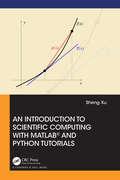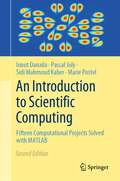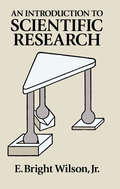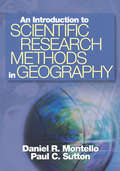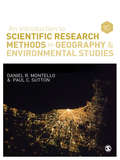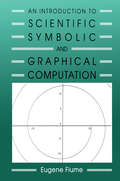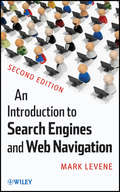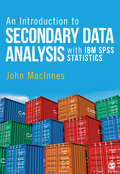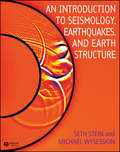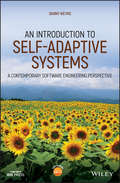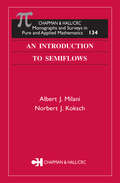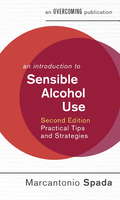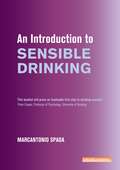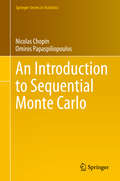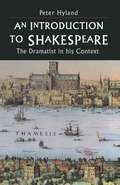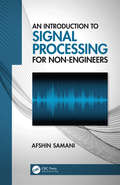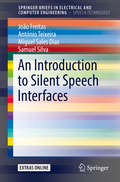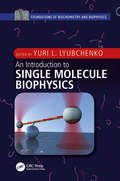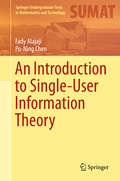- Table View
- List View
An Introduction to Scientific Computing with MATLAB® and Python Tutorials
by Sheng XuThis textbook is written for the first introductory course on scientific computing. It covers elementary numerical methods for linear systems, root finding, interpolation, numerical integration, numerical differentiation, least squares problems, initial value problems and boundary value problems. It includes short Matlab and Python tutorials to quickly get students started on programming. It makes the connection between elementary numerical methods with advanced topics such as machine learning and parallel computing. This textbook gives a comprehensive and in-depth treatment of elementary numerical methods. It balances the development, implementation, analysis and application of a fundamental numerical method by addressing the following questions. •Where is the method applied?•How is the method developed?•How is the method implemented?•How well does the method work? The material in the textbook is made as self-contained and easy-to-follow as possible with reviews and remarks. The writing is kept concise and precise. Examples, figures, paper-and-pen exercises and programming problems are deigned to reinforce understanding of numerical methods and problem-solving skills.
An Introduction to Scientific Computing: Fifteen Computational Projects Solved with MATLAB
by Ionut Danaila Pascal Joly Sidi Mahmoud Kaber Marie PostelThis book demonstrates scientific computing by presenting twelve computational projects in several disciplines including Fluid Mechanics, Thermal Science, Computer Aided Design, Signal Processing and more. Each follows typical steps of scientific computing, from physical and mathematical description, to numerical formulation and programming and critical discussion of results. The text teaches practical methods not usually available in basic textbooks: numerical checking of accuracy, choice of boundary conditions, effective solving of linear systems, comparison to exact solutions and more. The final section of each project contains the solutions to proposed exercises and guides the reader in using the MATLAB scripts available online.
An Introduction to Scientific Research
by E. Bright Wilson Jr.This book is intended to assist scientists in planning and carrying out research. However, unlike most books dealing with the scientific method, which stress its philosophical rationale, this book is written from a practical standpoint. It contains a rich legacy of principles, maxims, procedures and general techniques that have been found useful in a wide range of sciences.While much of the material is accessible to a college senior, the book is more specifically intended for students beginning research and for those more experienced research workers who wish an introduction to various topics not included in their training. Mathematical treatments have been kept as elementary as possible to make the book accessible to a broad range of scientists. Its principles and rules can be absorbed to advantage by workers in such diverse fields as agriculture, industrial and military research, biology and medicine as well as in the physical sciences.After discussing such basics as the choice and statement of a research problem and elementary scientific method, Professor Wilson offers lucid and helpful discussions of the design of experiments and apparatus, execution of experiments, analysis of experimental data, errors of measurement, numerical computation and other topics. A final chapter treats the publication of research results.Although no book can substitute for actual scientific work, this highly pragmatic compendium contains much knowledge gained the hard way through years of actual practice. Moreover, the author has illustrated the ideas discussed with as many actual examples as possible. In addition, he has included notes and references at the end of each chapter to enable readers to investigate particular topics more deeply. E. Bright Wilson, Jr. is a distinguished scientist and educator whose previous works include Molecular Vibrations and Introduction to Quantum Mechanics (with Linus Pauling). In the present book, he has distilled years of experiment and experience into an indispensable broad-based guide for any scientific worker tackling a research problem.
An Introduction to Scientific Research Methods in Geography and Environmental Studies
by Daniel R. Montello Paul Sutton"Montello and Sutton is one of the best texts I've used in seminars on research methodology. The text offers a clear balance of quantitative vs. qualitative and physical vs. human which I've found particularly valuable. The chapters on research ethics, scientific communication, information technologies and data visualization are excellent" - Kenneth E. Foote, Department of Geography, University of Colorado at Boulder This is a broad and integrative introduction to the conduct and interpretation of scientific research, covering both geography and environmental studies. Written for undergraduate and postgraduate students, it: Explains both the conceptual and the technical aspects of research, as well as all phases of the research process Combines approaches in physical geography and environmental science, human geography and human-environment relations, and geographic and environmental information techniques (such as GIS, cartography, and remote sensing) Combines natural and social scientific approaches common to subjects in geography and environmental studies Includes case studies of actual research projects to demonstrate the breadth of approaches taken It will be core reading for students studying scientific research methods in geography, environmental studies and related disciplines such as planning and earth science.
An Introduction to Scientific Research Methods in Geography and Environmental Studies
by Daniel R. Montello Paul Sutton"Covers a broad range of subjects that undergraduates in the discipline should be familiar and comfortable with upon graduation. From chapters on the scientific method and fundamental research concepts, to experimental design, sampling and statistical analysis, the text offers an excellent introduction to the key concepts of geographical research. The content is applicable for students at the beginning of their studies right through to planning and conducting dissertations. The book has also been of particular support in designing my level 1 and 2 tutorials which cover similar ground to several of the chapters." - Joseph Mallalieu, School of Geography, Leeds University "Montello and Sutton is one of the best texts I've used in seminars on research methodology. The text offers a clear balance of quantitative vs. qualitative and physical vs. human which I've found particularly valuable. The chapters on research ethics, scientific communication, information technologies and data visualization are excellent." - Kenneth E. Foote, Department of Geography, University of Colorado at Boulder This is a broad and integrative introduction to the conduct and interpretation of scientific research, covering both geography and environmental studies. Written for undergraduate and postgraduate students, it: Explains both the conceptual and the technical aspects of research, as well as all phases of the research process Combines approaches in physical geography and environmental science, human geography and human-environment relations, and geographic and environmental information techniques (such as GIS, cartography, and remote sensing) Combines natural and social scientific approaches common to subjects in geography and environmental studies Includes case studies of actual research projects to demonstrate the breadth of approaches taken It will be core reading for students studying scientific research methods in geography, environmental studies and related disciplines such as planning and earth science.
An Introduction to Scientific, Symbolic, and Graphical Computation
by Eugene FiumeThis down-to-earth introduction to computation makes use of the broad array of techniques available in the modern computing environment. A self-contained guide for engineers and other users of computational methods, it has been successfully adopted as a text in teaching the next generation of mathematicians and computer graphics majors.
An Introduction to Search Engines and Web Navigation
by Mark LeveneThis book is a second edition, updated and expanded to explain the technologies that help us find information on the web. Search engines and web navigation tools have become ubiquitous in our day to day use of the web as an information source, a tool for commercial transactions and a social computing tool. Moreover, through the mobile web we have access to the web's services when we are on the move. This book demystifies the tools that we use when interacting with the web, and gives the reader a detailed overview of where we are and where we are going in terms of search engine and web navigation technologies.
An Introduction to Second Language Acquisition Research (Applied Linguistics and Language Study)
by Diane Larsen-Freeman Michael H. LongUnderstanding how people learn and fail to learn second and foreign languages is increasingly recognised as a critical social and psycholinguistic issue. Second languages are vitally important to diverse groups of people, ranging from refugees to college students facing foreign language requirements. This book provides a synthesis of empirical findings on second and foreign language learning by children and adults, emphasising the design and execution of appropriate research.
An Introduction to Secondary Data Analysis with IBM SPSS Statistics
by Professor John MacInnesMany professional, high-quality surveys collect data on people's behaviour, experiences, lifestyles and attitudes. The data they produce is more accessible than ever before. This book provides students with a comprehensive introduction to using this data, as well as transactional data and big data sources, in their own research projects. Here you will find all you need to know about locating, accessing, preparing and analysing secondary data, along with step-by-step instructions for using IBM SPSS Statistics. You will learn how to: Create a robust research question and design that suits secondary analysis Locate, access and explore data online Understand data documentation Check and 'clean' secondary data Manage and analyse your data to produce meaningful results Replicate analyses of data in published articles and books Using case studies and video animations to illustrate each step of your research, this book provides you with the quantitative analysis skills you'll need to pass your course, complete your research project and compete in the job market. Exercises throughout the book and on the book's companion website give you an opportunity to practice, check your understanding and work hands on with real data as you're learning.
An Introduction to Secondary Data Analysis with IBM SPSS Statistics
by Professor John MacInnesMany professional, high-quality surveys collect data on people's behaviour, experiences, lifestyles and attitudes. The data they produce is more accessible than ever before. This book provides students with a comprehensive introduction to using this data, as well as transactional data and big data sources, in their own research projects. Here you will find all you need to know about locating, accessing, preparing and analysing secondary data, along with step-by-step instructions for using IBM SPSS Statistics. You will learn how to: Create a robust research question and design that suits secondary analysis Locate, access and explore data online Understand data documentation Check and 'clean' secondary data Manage and analyse your data to produce meaningful results Replicate analyses of data in published articles and books Using case studies and video animations to illustrate each step of your research, this book provides you with the quantitative analysis skills you'll need to pass your course, complete your research project and compete in the job market. Exercises throughout the book and on the book's companion website give you an opportunity to practice, check your understanding and work hands on with real data as you're learning.
An Introduction to Seismology, Earthquakes, and Earth Structure
by Michael Wysession Seth SteinAn Introduction to Seismology, Earthquakes and Earth Structures is an introduction to seismology and its role in the earth sciences, and is written for advanced undergraduate and beginning graduate students. The fundamentals of seismic wave propagation are developed using a physical approach and then applied to show how refraction, reflection, and teleseismic techniques are used to study the structure and thus the composition and evolution of the earth. The book shows how seismic waves are used to study earthquakes and are integrated with other data to investigate the plate tectonic processes that cause earthquakes. Figures, examples, problems, and computer exercises teach students about seismology in a creative and intuitive manner. Necessary mathematical tools including vector and tensor analysis, matrix algebra, Fourier analysis, statistics of errors, signal processing, and data inversion are introduced with many relevant examples. The text also addresses the fundamentals of seismometry and applications of seismology to societal issues. Special attention is paid to help students visualize connections between different topics and view seismology as an integrated science. An Introduction to Seismology, Earthquakes, and Earth Structure gives an excellent overview for students of geophysics and tectonics, and provides a strong foundation for further studies in seismology. Multidisciplinary examples throughout the text - catering to students in varied disciplines (geology, mineralogy, petrology, physics, etc.). Most up to date book on the market - includes recent seismic events such as the 1999 Earthquakes in Turkey, Greece, and Taiwan). Chapter outlines - each chapter begins with an outline and a list of learning objectives to help students focus and study. Essential math review - an entire section reviews the essential math needed to understand seismology. This can be covered in class or left to students to review as needed. End of chapter problem sets - homework problems that cover the material presented in the chapter. Solutions to all odd numbered problem sets are listed in the back so that students can track their progress. Extensive References - classic references and more current references are listed at the end of each chapter. A set of instructor's resources containing downloadable versions of all the figures in the book, errata and answers to homework problems is available at: http://levee.wustl.edu/seismology/book/. Also available on this website are PowerPoint lecture slides corresponding to the first 5 chapters of the book.
An Introduction to Self-adaptive Systems: A Contemporary Software Engineering Perspective (Wiley - IEEE)
by Danny WeynsA concise and practical introduction to the foundations and engineering principles of self-adaptation Though it has recently gained significant momentum, the topic of self-adaptation remains largely under-addressed in academic and technical literature. This book changes that. Using a systematic and holistic approach, An Introduction to Self-adaptive Systems: A Contemporary Software Engineering Perspective provides readers with an accessible set of basic principles, engineering foundations, and applications of self-adaptation in software-intensive systems. It places self-adaptation in the context of techniques like uncertainty management, feedback control, online reasoning, and machine learning while acknowledging the growing consensus in the software engineering community that self-adaptation will be a crucial enabling feature in tackling the challenges of new, emerging, and future systems. The author combines cutting-edge technical research with basic principles and real-world insights to create a practical and strategically effective guide to self-adaptation. He includes features such as: An analysis of the foundational engineering principles and applications of self-adaptation in different domains, including the Internet-of-Things, cloud computing, and cyber-physical systems End-of-chapter exercises at four different levels of complexity and difficulty An accompanying author-hosted website with slides, selected exercises and solutions, models, and code Perfect for researchers, students, teachers, industry leaders, and practitioners in fields that directly or peripherally involve software engineering, as well as those in academia involved in a class on self-adaptivity, this book belongs on the shelves of anyone with an interest in the future of software and its engineering.
An Introduction to Semiflows
by Albert J. Milani Norbert J. KokschThis book introduces the class of dynamical systems called semiflows, which includes systems defined or modeled by certain types of differential evolution equations (DEEs). It focuses on the basic results of the theory of dynamical systems that can be extended naturally and applied to study the asymptotic behavior of the solutions of DEEs. The auth
An Introduction to Sensible Alcohol Use, 2nd Edition: Practical Tips and Strategies
by Marcantonio SpadaLearn how to manage your alcohol use simply and effectivelyFor many, drinking can be a pleasurable, acceptable and harmless social activity. However, if you regularly drink more than is sensible you may find that it impacts on your health, emotional wellbeing, relationships and your ability to work. There are many reasons why we drink and this self-help guide uses clinically proven cognitive behavioural therapy (CBT) techniques to help you to work out your own reasons and to start taking control of your alcohol use: Understand what is sensible alcohol useBuild the motivation to change your habitsTackle thoughts about drinkingManage setbacks
An Introduction to Sensible Alcohol Use, 2nd Edition: Practical Tips and Strategies (An Introduction to Coping series)
by Marcantonio SpadaLearn how to manage your alcohol use simply and effectivelyFor many, drinking can be a pleasurable, acceptable and harmless social activity. However, if you regularly drink more than is sensible you may find that it impacts on your health, emotional wellbeing, relationships and your ability to work. There are many reasons why we drink and this self-help guide uses clinically proven cognitive behavioural therapy (CBT) techniques to help you to work out your own reasons and to start taking control of your alcohol use: Understand what is sensible alcohol useBuild the motivation to change your habitsTackle thoughts about drinkingManage setbacks
An Introduction to Sensible Drinking (An Introduction to Coping series)
by Marcantonio SpadaLearn how to manage your alcohol use simply and effectivelyFor many, drinking can be a pleasurable, acceptable and harmless social activity. However, if you regularly drink more than is sensible you may find that it impacts on your health, emotional wellbeing, relationships and your ability to work. There are many reasons why we drink and this self-help guide uses clinically proven cognitive behavioural therapy (CBT) techniques to help you to work out your own reasons and to start taking control of your alcohol use: Understand what is sensible alcohol useBuild the motivation to change your habitsTackle thoughts about drinkingManage setbacks
An Introduction to Sensible Drinking: Practical Tips and Strategies (Overcoming Ser.)
by Marcantonio SpadaLearn how to manage your alcohol use simply and effectivelyFor many, drinking can be a pleasurable, acceptable and harmless social activity. However, if you regularly drink more than is sensible you may find that it impacts on your health, emotional wellbeing, relationships and your ability to work. There are many reasons why we drink and this self-help guide uses clinically proven cognitive behavioural therapy (CBT) techniques to help you to work out your own reasons and to start taking control of your alcohol use: Understand what is sensible alcohol useBuild the motivation to change your habitsTackle thoughts about drinkingManage setbacks
An Introduction to Sequential Monte Carlo (Springer Series in Statistics)
by Nicolas Chopin Omiros PapaspiliopoulosThis book provides a general introduction to Sequential Monte Carlo (SMC) methods, also known as particle filters. These methods have become a staple for the sequential analysis of data in such diverse fields as signal processing, epidemiology, machine learning, population ecology, quantitative finance, and robotics.The coverage is comprehensive, ranging from the underlying theory to computational implementation, methodology, and diverse applications in various areas of science. This is achieved by describing SMC algorithms as particular cases of a general framework, which involves concepts such as Feynman-Kac distributions, and tools such as importance sampling and resampling. This general framework is used consistently throughout the book.Extensive coverage is provided on sequential learning (filtering, smoothing) of state-space (hidden Markov) models, as this remains an important application of SMC methods. More recent applications, such as parameter estimation of these models (through e.g. particle Markov chain Monte Carlo techniques) and the simulation of challenging probability distributions (in e.g. Bayesian inference or rare-event problems), are also discussed.The book may be used either as a graduate text on Sequential Monte Carlo methods and state-space modeling, or as a general reference work on the area. Each chapter includes a set of exercises for self-study, a comprehensive bibliography, and a “Python corner,” which discusses the practical implementation of the methods covered. In addition, the book comes with an open source Python library, which implements all the algorithms described in the book, and contains all the programs that were used to perform the numerical experiments.
An Introduction to Severe Storms and Hazardous Weather
by Jeffrey B. HalversonThis book presents a deep and encompassing survey of severe weather in all its forms. An Introduction to Severe Storms and Hazardous Weather is an exciting new textbook that allows students to learn the principles of atmospheric science through the drama, exhilaration, and even tragedy of severe weather.Balancing breadth and depth, Jeffrey B. Halverson adeptly combines a short, accessible introduction to the basic principles of meteorology with detailed coverage on large- and small-scale weather hazards. He draws on specific up-to-date case studies from North America to illustrate the cause of meteorological events including hurricanes, heavy snow and ice, floods, and tornadoes. Unlike existing books on the market, Halverson delves deep into the societal impacts of these events, drawing on examples from agriculture, utility infrastructure, and commercial aviation. Each chapter also features high-quality, customized color artwork by Thomas D. Rabenhorst that helps to enhance and embed learning.Thorough in its scope, and written with an impeccable focus on the science, this book will be an essential resource for introductory undergraduate courses in severe weather, natural hazards, and extreme meteorology. It is also an excellent supplemental textbook for courses on meteorology and atmospheric science.
An Introduction to Shakespeare
by Marchette ChuteFor children, a biography of William Shakespeare with very short synopses of his plays.
An Introduction to Shakespeare
by Peter HylandPeter Hyland provides a highly readable account of the historical, social and political pressures of Shakespeare's England and the material conditions under which his plays were written, including a comprehensive description of the development and status of the theatrical profession. Half of the book is given over to a survey of the plays and examines numerous controversial issues that arise when we ask precisely what we can 'know' about them. For those who are daunted by the volume or the impenetrable prose of much recent writing on Shakespeare, Hyland's book will be a stimulating introduction.
An Introduction to Signal Processing for Non-Engineers
by Afshin SamaniThis book introduces the basic concepts of signal processing for scientists and students with no engineering background. The book presents the concepts with minimum use of mathematical formulations and more emphasis on visual illustrations. The idea is to present an intuitive approach to understanding the basics of signal processing and exemplify some practical applications of the concepts by which the readers achieve basic knowledge and skills in signal processing. Most of illustrations in the book have been created by computer programming in MATLAB®; thus, the reader will learn the basics of using computers in signal processing applications.
An Introduction to Silent Speech Interfaces (SpringerBriefs in Speech Technology)
by João Freitas António Teixeira Miguel Sales Dias Samuel SilvaThis book provides a broad and comprehensive overview of the existing technical approaches in the area of silent speech interfaces (SSI), both in theory and in application. Each technique is described in the context of the human speech production process, allowing the reader to clearly understand the principles behind SSI in general and across different methods. Additionally, the book explores the combined use of different data sources, collected from various sensors, in order to tackle the limitations of simpler SSI approaches, addressing current challenges of this field. The book also provides information about existing SSI applications, resources and a simple tutorial on how to build an SSI.
An Introduction to Single Molecule Biophysics (Foundations of Biochemistry and Biophysics)
by Yuri L. LyubchenkoThis book gives an accessible, detailed overview on techniques of single molecule biophysics (SMB), showing how they are applied to numerous biological problems associated with understanding the molecular mechanisms of DNA replication, transcription, and translation, as well as functioning of molecular machines. It covers major single molecule imaging and probing techniques, highlighting key strengths and limitations of each method using recent examples. The chapters begin with a discussion of single molecule fluorescence techniques followed by an overview of the atomic force microscope and its use for direct time-lapse visualization of dynamics of molecular complexes at the nanoscale, as well as applications in measurements of interactions between molecules and mechanical properties of isolated molecules and their complexes. The next chapters address magnetic tweezers and optical tweezers, including instrumentation, fundamentals of operation, and applications. A final chapter turns to nanopore transport and nanopore-based DNA sequencing technology that will play a major role in next-generation genomics and healthcare applications.
An Introduction to Single-User Information Theory (Springer Undergraduate Texts in Mathematics and Technology)
by Fady Alajaji Po-Ning ChenThis book presents a succinct and mathematically rigorous treatment of the main pillars of Shannon’s information theory, discussing the fundamental concepts and indispensable results of Shannon’s mathematical theory of communications. It includes five meticulously written core chapters (with accompanying problems), emphasizing the key topics of information measures; lossless and lossy data compression; channel coding; and joint source-channel coding for single-user (point-to-point) communications systems. It also features two appendices covering necessary background material in real analysis and in probability theory and stochastic processes.The book is ideal for a one-semester foundational course on information theory for senior undergraduate and entry-level graduate students in mathematics, statistics, engineering, and computing and information sciences. A comprehensive instructor’s solutions manual is available.
